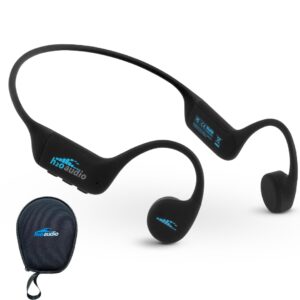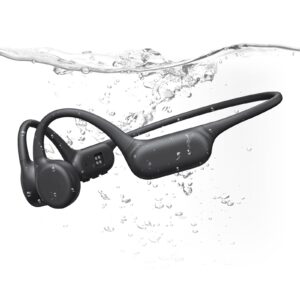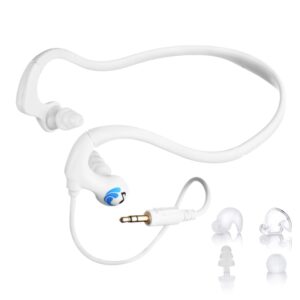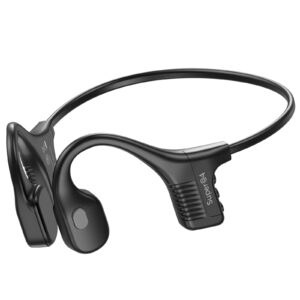We independently select all products and services. If you click through links we provide, Mighty Deals may earn a commission.
Wearing headphones during a triathlon is a personal choice, but for many athletes, music or audio can provide a welcome boost throughout training or on race day—when allowed. Triathlon headphones are designed to withstand challenging conditions like sweat, rain, and hours of continuous movement. The best models are both comfortable and secure, even when running, cycling, or transitioning between events.
When shopping for triathlon headphones, it’s important to focus on water resistance, fit, and battery life. Sweat and rain can quickly ruin standard headphones, so a reliable waterproof rating is essential. Additionally, headphones should offer a stable fit that won’t fall out as you move, and enough battery to last your longest sessions.
Choosing the right headphones can help make every workout more enjoyable and distraction-free. We spent hours researching and testing several triathlon headphones to find the best options for athletes.
Best Triathlon Headphones
We’ve reviewed and selected the best triathlon headphones for every type of athlete. Our picks are designed to handle swimming, cycling, and running so you can stay focused on your race. Here are our top choices for reliable and comfortable headphones.
1. H2O Audio TRI 2 Multisport Headphones
For triathletes who want reliable, waterproof headphones that work both on land and in the water, this is a solid pick but comes with a few trade-offs.
Pros
- Easy to switch between music and calls during runs, bike rides, and swims
- Stays comfortable and secure thanks to a soft, open-ear design
- 8GB built-in memory means we can store plenty of songs for swim sessions
Cons
- Button controls can feel a bit clunky, especially with wet hands
- The audio will sometimes skip or play out of order in MP3 mode
- Durability concerns with the charging cable and connectors
The fit and feel of the TRI 2 are excellent. We found the open design keeps our ears free, so we’re still aware of the environment during the run or ride portions of training. While the silicone finish adds comfort, it’s the hard shell case that really helps with storage and protection.
Switching between Bluetooth for land workouts and MP3 mode for swims is straightforward, and makes these headphones versatile. Audio quality is about what we expect from bone conduction—it won’t blow audiophiles away, but it’s clear enough for music, podcasts, and calls. Having 8GB of internal storage is practical as it eliminates the need for our phone in the pool.
We did notice a few annoyances. Sometimes the button controls are tricky to use when we’re wet, and the playlist order can get jumbled in MP3 mode. Over time, we’re also cautious since a few users have reported issues with the charging cable and connectors. Despite these drawbacks, the H2O Audio TRI 2 Multisport Headphones deliver on waterproof performance and flexibility for multi-sport athletes.
2. PSIER Swimming Headphones
If we need headphones that handle both pool and land workouts while staying comfortable, these are a practical option.
Pros
- Comfortable open-ear fit for long sessions
- Fully waterproof, ideal for swimming
- Reliable battery keeps us powered all day
Cons
- Sound quality isn’t as rich when fully submerged
- Needs occasional manual song transfers for MP3 use
- Fit adjustment might be necessary for smaller heads
Sliding these on before a morning swim, we immediately noticed the soft silicone cushions hugged the front of our ears without feeling tight. The open-ear design helped us stay aware of our surroundings while running or cycling, keeping safety in mind during all training sessions.
Switching easily between Bluetooth and MP3 mode means we aren’t tethered to our phone, especially in the pool. Loading tracks is straightforward, and having up to 4,000 songs on hand kept our music fresh. Pairing was seamless with all our devices, which minimized frustration before a workout.
The IPX8 waterproof rating gave us confidence to take them from lap swimming to rainy bike rides with no issues. While the audio holds up well above water, sound does thin out during extended underwater use. We found the controls easy to manage mid-activity and appreciated that the battery consistently lasted through even our longest workouts.
Overall, PSIER Swimming Headphones offer versatility and comfort for any triathlete looking for a fuss-free, reliable audio solution for training in any environment.
3. HydroActive Premium Waterproof Headphones
Anyone looking for a reliable pair of headphones specifically for the swim portion of a triathlon will find these a practical option, though sound and build quality may not satisfy everyone.
Pros
- Holds securely during laps and flip turns
- Stays comfortable through longer sessions
- Wrap-around design doesn’t interfere with caps or goggles
Cons
- Sound quality feels flat compared to others
- Materials and finish seem less robust
- Separate player purchase is needed
When we used these headphones in the pool, we noticed right away that the secure fit made a huge difference compared to basic earbuds that always seem to fall out mid-lap. They stay put through all types of aquatic movement, so there’s no fiddling or frustration.
Comfort doesn’t take a back seat, even during longer training sets. The wrap-around band and easy setup let us put them on and forget about them. They’re easy to slip on, even with swim caps and goggles in place, which expedites transitions at busy pools. The short cord is perfect when our music player is clipped close by, and the included extender helps if we need more reach.
That said, the sound quality left us wanting a bit more. Audio felt thin and a bit “metallic” at times—okay for simple playlists or podcasts, but not something we’d recommend for audiophiles. The plastic parts and finish don’t feel luxurious, either, and some subtle discoloration appeared quickly. It’s worth highlighting that if you don’t already have a compatible waterproof music player, you’ll need to buy one separately, which adds to the overall cost.
4. YouthWhisper Bone Conduction Swimming Headphones
These headphones are a smart pick for triathletes who want to enjoy music during every training session, even while swimming.
Pros
- Secure, lightweight fit isn’t distracting during workouts
- Stays reliable even underwater thanks to strong waterproofing
- Built-in MP3 mode offers freedom from our phones
Cons
- Sound quality underwater isn’t as full as on dry land
- Physical buttons take some getting used to
- Can feel a bit snug on larger heads
We found the open-ear design makes a real difference, especially when we’re swapping between busy streets and the pool. Training outdoors or riding in a group, we stayed aware of traffic while still enjoying playlists or catching up on podcasts. There’s no ear fatigue even after hours of wear, which is a standout benefit.
Switching to MP3 mode before diving into the pool is quick and easy. With plenty of space for songs, we didn’t have to bring a phone along to swim a full session. The waterproofing truly holds up at depth—no worrying about the occasional splash or submersion.
Stability during movement impressed us; these headphones didn’t budge, no matter how tough the bike or run. The only caveat is that pushing the physical buttons requires a little practice. For triathletes who want versatility plus reliable all-day battery life, these headphones deliver what we need without overcomplicating things.
Buying Guide
When picking triathlon headphones, we need to look for a secure and comfortable fit. Earbuds that stay in place, even when sweating or moving quickly, are important.
Water resistance is key. We should always check for an IP rating, as this helps protect headphones from water and sweat during swimming or rainy runs.
Battery life is another top priority. We want a pair that lasts through the longest training sessions and races, so checking battery details is essential.
Let’s remember sound quality matters if we’re using music or tracking apps. Clear audio ensures we can hear music, coaching cues, or updates, even in busy environments.
Key Features to Consider:
- Water resistance: Higher IP rating means better protection.
- Fit: Secure over-ear or ear-hook designs help.
- Battery life: At least 6-8 hours is useful.
- Controls: Easy-to-press buttons or touch controls for wet hands.
- Connectivity: Strong and stable Bluetooth connection.
| Feature | What to Look For |
|---|---|
| Water Resistance | IPX7 or higher recommended |
| Fit | Secure, comfortable, adjustable |
| Battery Life | 6+ hours per charge |
| Controls | Easy to use, tactile |
| Connectivity | Reliable Bluetooth |
We should check return policies and warranties. Trying headphones before buying, if possible, can help us find the right fit for our needs.
Frequently Asked Questions
We want headphones that will work through water, sweat, and long hours. Comfort, battery life, and fit are especially important when we’re balancing swimming, biking, and running.
What are the top rated waterproof headphones for swimming in a triathlon?
Some of the most recommended waterproof headphones for swimming are the Shokz OpenSwim and H2O Audio Tri Pro Multi-Sport. Both can be fully submerged and provide stable sound underwater.
The Sony NW-WS413 is another popular option due to its secure fit and waterproof design.
Which bone conduction headphones are recommended for triathlon training?
Shokz OpenRun and Shokz OpenSwim are the main bone conduction models used by triathletes. We find these comfortable and they let us stay aware of our surroundings.
Vidonn F3 is an affordable alternative that many athletes prefer for training.
How do Shokz OpenSwim headphones perform for triathletes?
The Shokz OpenSwim models are lightweight and fit securely, even during fast swims. They store music directly on the device, so no phone connection is needed.
Sound quality holds up well in water, and the open-ear design lets us hear outside noise when biking or running.
What features should triathletes look for in earbuds for running and cycling stages?
We should look for a secure fit, sweat resistance, and easy controls while moving. Good battery life helps for long sessions.
A strong, stable connection and clear audio are also useful on the bike and run.
Are there any wireless headphones suitable for all stages of a triathlon?
Headphones with multi-sport or waterproof ratings, such as H2O Audio Tri Pro, can work for all three stages. Fully submersible models with strong batteries and a secure fit are the best choices for race day.
What are the best options for triathlon headphones with long battery life?
Shokz OpenRun Pro offers up to 10 hours of use. Sony NW-WS623 and H2O Audio Tri Pro can both last 8-12 hours per charge, covering most long workouts and races.
Having a charging case or fast-charging support is also helpful for back-to-back sessions.





